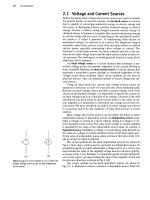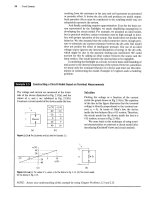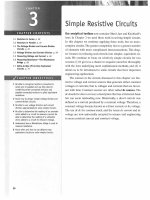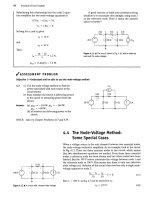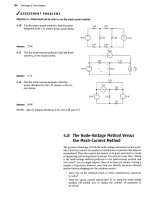Electric Circuits, 9th Edition P54 docx
Bạn đang xem bản rút gọn của tài liệu. Xem và tải ngay bản đầy đủ của tài liệu tại đây (309.62 KB, 10 trang )
506 The Laplace Transform in Circuit Analysis
Summary
• We can represent each of the circuit elements as an
6-domain equivalent circuit by Laplace-transforming
the voltage-current equation for each element:
• Resistor: V = RI
• Inductor: V - sLl - LI
()
• Capacitor: V = (l/sC)I + VJs
In these equations, V = Z£{v}, I = ?£{i}, /
0
is the ini-
tial current through the inductor, and V
0
is the initial
voltage across the capacitor. (See pages 468-469.)
• We can perform circuit analysis in the s domain by
replacing each circuit element with its s-domain equiva-
lent circuit. The resulting equivalent circuit is solved by
writing algebraic equations using the circuit analysis
techniques from resistive circuits. Table 13.1 summa-
rizes the equivalent circuits for resistors, inductors, and
capacitors in the s domain. (See page 470.)
• Circuit analysis in the s domain is particularly advanta-
geous for solving transient response problems in linear
lumped parameter circuits when initial conditions are
known. It is also useful for problems involving multiple
simultaneous mesh-current or node-voltage equations,
because it reduces problems to algebraic rather than
differential equations. (See pages 476-478.)
• The transfer function is the s-domain ratio of a circuit's
output to its input. It is represented as
where Y(s) is the Laplace transform of the output sig-
nal,
and X(s) is the Laplace transform of the input sig-
nal.
(See page 484.)
• The partial fraction expansion of the product H(s)X(s)
yields a term for each pole of H(s) and X(s). The
H(s) terms correspond to the transient component of
the total response; the X(s) terms correspond to the
steady-state component. (See page 486.)
• If a circuit is driven by a unit impulse, x(t) = 8(t), then
the response of the circuit equals the inverse Laplace
transform of the transfer function, y(t) = !£~
l
{H(s)}
= h(t). (See pages 488-489.)
• A time-invariant circuit is one for which, if the input is
delayed by a seconds, the response function is also
delayed by a seconds. (See page 488.)
• The output of a circuit, y(t), can be computed by con-
volving the input, x(t), with the impulse response of the
circuit, h(t):
y{t) = h{t) * x{t) = / h{k)x{t - \)dk
Jo
= x{t) * h{t) = j x(\)h(t - A)d\.
JO
A graphical interpretation of the convolution integral
often provides an easier computational method to gen-
erate y(t). (See page 489.)
• We can use the transfer function of a circuit to compute
its steady-state response to a sinusoidal source. To do so,
make the substitution s =
j<o
in H(s) and represent the
resulting complex number as a magnitude and phase
angle. If
x(t) = A cos((ot + ¢),
Hijco) = \H(jco)\e
m
"K
then
yjjt) = A\H(ja>)\
cos[e*t
+ ¢ +
$(<*>)),
(See page 496.)
• Laplace transform analysis correctly predicts impulsive
currents and voltages arising from switching and impul-
sive sources. You must ensure that the ^-domain equiva-
lent circuits are based on initial conditions at t = (T,
that
is,
prior to the switching. (See page 498.)
Problems 507
Problems
Section 13.1
13.1 Derive the .s-domain equivalent circuit shown in
Fig. 13.4 by expressing the inductor current i as a
function of the terminal voltage v and then find-
ing the Laplace transform of this time-domain
integral equation.
13.2 Find the Thevenin equivalent of the circuit shown
in Fig. 13.7.
13.3 Find the Norton equivalent of the circuit shown
in Fig. 13.3.
Section 13.2
13.4 A 2 kil resistor, a 312.5 mH inductor, and a 12.5 nF
capacitor are in parallel.
a) Express the s-domain impedance of this parallel
combination as a rational function.
b) Give the numerical values of the poles and zeros
of the impedance.
13.5 A 1 kd resistor is in series with a 625 nF capaci-
tor. This series combination is in parallel with a
100 mH inductor.
a) Express the equivalent s-domain impedance of
these parallel branches as a rational function.
b) Determine the numerical values of the poles
and zeros.
13.6 A 8 kO resistor, a
1
H inductor, and a 40 nF capaci-
tor are in series.
a) Express the s-domain impedance of this series
combination as a rational function.
b) Give the numerical value of the poles and zeros
of the impedance.
13.7 Find the poles and zeros of the impedance seen
looking into the terminals a,b of the circuit shown
in Fig. PI3.7.
Figure PI3.7
13.8 Find the poles and zeros of the impedance seen
looking into the terminals a,b of the circuit shown
in Fig. P13.8.
Figure P13.8
h.
1F^
<
IF;:
IH 5
•in
iia
Section 13.3
13.9 The switch in the circuit shown in Fig. PI 3.9 has
PSPICE been in position x for a long time. At t = 0, the
* switch moves instantaneously to position y.
a) Construct an .v-domain circuit for t > 0.
b) Find V
ot
c) Find v
0
.
Figure P13.9
13.10 The switch in the circuit in Fig. P13.10 has been in
position a for a long
time.
At t - 0, it moves instan-
taneously from a to b.
a) Construct the s-domain circuit for t > 0.
b) Find
V
a
(s).
c) Find v„(t) for t > 0.
Figure P13.10
12511
50 V
137.5
V
10
mH
13.11 The switch in the circuit in Fig. P13.ll has been
PSPICE closed for a long time before opening at t ~ 0,
MULTISIM
a) Construct the .y-domain equivalent circuit for
t > 0.
b) Find V
a
,
508 The
Laplace Transform
in
Circuit
Analysis
c) Find
v
()
for t > 0.
Figure P13.ll
10
mF
8(2
2H
PSPKE
MULTISIM
13.12
The
switch
in the
circuit
in
Fig. P13.12
has
been
in
position
a for a
long time.
At if = 0, the
switch
moves instantaneously
to
position
b.
a) Construct the ^-domain circuit
for t > 0.
b) Find
V
a
.
c) Find
/
L
.
d) Find
v
()
for t > 0.
e) Find
i
L
for t > 0.
Figure P13.12
6.25
JX¥
/
= 0
20
ft
son
+
6.4 rnH
v„
13.13
The
switch
in the
circuit
in Fig.
P13.13
has
been
PSPICE
closed
for a
long time.
At t = 0, the
switch
MULTISIM
• j
is opened.
a) Find
v
a
for t ^ 0.
b) Find
i
a
for t > 0.
Figure
P13.13
t
= 0
PYn
125
nF
4kfl
-AW-
20
V
i
0.5
H-
13.14
The
make-before-break switch
in the
circuit
in
PSPICE
Fig. PI3.14 has been
in
position
a for a
long time.
At
MULTisiM
?
= o, it
moves instantaneously
to
position b. Find
i
0
for
t > 0.
Figure P13.14
(3)
500 V
10 mF
13.15 Find
V
0
and
v
a
in the
circuit shown
in
Fig. P13.15
if
PSPICE
the
initial energy
is
zero
and the
switch
is
closed
at
MULTISIM
f
=
0
Figure
P13.15
2.8 kll 200 mH
t
= 0
125 nF
D„
13.16 Repeat Problem 13.15
if the
initial voltage
on the
PSPICE
capacitor
is
30
V
positive
at the
upper terminal.
MULTISIM
13.17
The
switch
in the
circuit seen
in
Fig. PI3.17 has been
PSPICE
i
n
position
a for a
long time before moving instanta-
MULTISIM
neously
to
position
b at t = 0.
a) Construct
the
s-domain equivalent circuit
for
t
> 0.
b) Find
V\ and v^.
c) Find
V
2
and v
2
.
Figure
P13.17
450 V
1.25 mH
16/UJF:
24^F
13.18 The switch
in
the circuit seen
in
Fig. P13.18 has been
PSPICE
i
n
position
a for a
long time.
At t = 0, it
moves
MULTISIM
instantaneously to position b.
a) FindV
fr
b) Finder
Problems 509
Figure P13.18
20 a
13.19 The switch in the circuit in Fig. P13.19 has been
PSPICE closed for a long time before opening at t = 0. Find
MULTISIM
c
+ -^ n
v
n
for t > 0.
Figure P13.19
13.20 Find v
()
in the circuit shown in Fig. PI3.20 if
PSP1CE
L = 5u(t) mA. There is no energy stored in the cir-
MULTISIM
h
.,
n
cuit at t = 0.
Figure P13.20
13.21 There is no energy stored in the circuit in Fig. PI3.21
PSPICE
at the time the switch is closed.
MULTISIM
a) Find v
0
for JsO.
b) Does your solution make sense in terms of
known circuit behavior? Explain.
Figure P13.21
2H
t
=
0 + "A
+ 1H
_ 4mF
35 V
0AvM)v
o
&V
13.22 There is no energy stored in the circuit in
Fig.
PI3.22
PSPICE
MULTISIM
at t = 0~.
a) Use the mesh current method to find i
a
.
b) Find the time domain expression for v
0
.
c) Do your answers in (a) and (b) make sense in
terms of known circuit behavior? Explain.
Figure P13.22
10//(0 V
in
»1
H
1 F
13.23 a) Find the s-domain expression for V
0
in the circuit
_™_
in Fig. PI3.23.
MULTISIM
b) Use the ^-domain expression derived in (a) to
predict the initial- and final-values of v
a
.
c) Find the time-domain expression for v
()
.
Figure P13.23
|15w(0mA jlH
7n
^vw-
+
;O.IF
v„
13.24 Find the time-domain expression for the current in
PSPICE
the inductor in Fig. P13.23. Assume the reference
MULTISIM
¢^¢^0]}
f
or
/
£
j
s
down.
13.25 There is no energy stored in the capacitors in the
PSPICE circuit in Fig. P13.25 at the time the switch is closed.
MULTIsiM , , ,
n
a) Construct the s-domain circuit tor t > 0.
b) Find I
h
V
h
and V
2
.
c) Find z'i, Vi, and i>
2
.
d) Do your answers for i
h
V\, and v
2
make sense in
terms of known circuit behavior? Explain.
Figure PI3.25
50
kn
300
nF
20 V
100
nF
13.26 There is no energy stored in the circuit in Fig. PI3.26
PSPICE at the time the voltage source is turned on, and
MULTISIM
^
= 75u{()
y
a) Find V
0
and I
0
.
b) Find v
0
and i
a
.
c) Do the solutions for v
a
and i
a
make sense in
terms of known circuit behavior? Explain.
510 The
Laplace Transform
in
Circuit
Analysis
Figure
P13.26
4mF
if
ion
10
n
:20 II
13.27 There is no energy stored in the circuit in Fig. PI 3.27
PSPI
« at the time the current source is energized.
MULTISIM
a) Find /
a
and I
b
.
b) Find /
a
and /
b
.
c) Find V
&i
V
bi
and V
c
.
d) Find t*
a
, v
h
, and v
c
.
e) Assume a capacitor will break down whenever
its terminal voltage is 1000 V. How long after the
current source turns on will one of the capacitors
break down?
Figure P13.27
lOOmF
+ v« -
ion
9«(0A(t
100 mF
Z
100 mF
ion
PSPICE
MULTISIM
13.28 There is no energy stored in the circuit in Fig. PI3.28
at t = 0".
a) Find V
a
.
b) Find v
a
.
c) Does your solution for v
0
make sense in terms of
known circuit behavior? Explain.
Figure P13.28
30 n
wv
40 mF
4H
50u(l)V|
ion
v„(J^$u(t)A
13.29 There is no energy stored in the circuit in Fig. PI 3.29
PSPICE
at the time the sources are energized.
MULTISIM
a) Find I^s) and
Ijis).
b) Use the initial- and final-value theorems to check
the initial- and final-values of i\{t) and /'2(f).
c) Find i
{
(t) and i
2
(t) for t > 0.
Figure
P13.29
ion
*-l\
2.5 H
6«(/)A( f
200 mF
:5n
75u(t) V
13,30 There is no energy stored in the circuit in Fig. P13.30
PSPICE
at the time the current source turns on. Given that
MULTISIM
ig = 5QHW A
.
a) Find V„(s).
b) Use the initial- and final-value theorems to find
v
o
(0
+
) and y
f)
(oo).
c) Determine if the results obtained in (b) agree
with known circuit behavior.
d) Find v
0
(t).
Figure P13.30
13.31 The initial energy in the circuit in Fig. P13.31 is zero.
PSPICE
The ideal voltage source is 120«(7) V.
MULTISIM
a) Find
I
a
(s).
b) Use the initial- and final-value theorems to find
i
a
(Q
+
)
and f
0
(oo).
c) Do the values obtained in (b) agree with known
circuit behavior? Explain.
d) Find /„(0.
Figure P13.31
20
<e>
so
n
%, 20 H
_4
CYV-V>_
+
:4 mF
700 O
13.32 There is no energy stored in the circuit in Fig. P13.32
PSPICE
at the time the voltage source is energized.
MULTISIM
a) Find V
()
, I
()
, and I
L
.
b) Find v
0
, f
(
„ and i
L
for t ^ 0.
Figure P13.32
Figure P13.35
Problems 511
-25f
5Qfe~**u(0 A
5H r
13.33 Beginning with Eq. 13,65, show that the capacitor
current in the circuit in Fig. 13.19 is positive for
0 < t < 200 (is and negative for t > 200 {is. Also
show that at 200 (is, the current is zero and that this
corresponds to when dv
c
/dt is zero.
PSPICE
MULTfSIM
13.34 The two switches in the circuit shown in Fig. P13.34
operate simultaneously. There is no energy stored
in the circuit at the instant the switches close. Find
/(f) for t & 0
+
by first finding the s-domain
Thevenin equivalent of the circuit to the left of the
terminals a,b.
Figure P13.34
40
V 2fjiF
13.35 The switch in the circuit shown in Fig. P13.35
has been open for a long time. The voltage of
the sinusoidal source is v
g
= V
m
sin
{cot
+
cj>).
The switch closes at / = 0. Note that the angle
cf)
in the voltage expression determines the value
of the voltage at the moment when the switch
closes, that is, v
g
(0) = V
m
sin
4>-
a) Use the Laplace transform method to find
/"
for t > 0.
b) Using the expression derived in (a), write the
expression for the current after the switch has
been closed for a long time.
c) Using the expression derived in (a), write the
expression for the transient component of /'.
d) Find the steady-state expression for i using the
phasor method. Verify that your expression is
equivalent to that obtained in (b).
e) Specify the value of
c/>
so that the circuit passes
directly into steady-state operation when the
switch is closed.
13.36 The magnetically coupled coils in the circuit seen
PSPICE
m
pjg_ pi 3.36 carry initial currents of 15 and 10 A,
MULTISIM ,
as shown.
a) Find the initial energy stored in the circuit.
b) Find I
{
and /
2
.
c) Find
i]
and i
2
.
d) Find the total energy dissipated in the 120 and
270 H resistors.
e) Repeat (a)-(d), with the dot on the 18 H induc-
tor at the lower terminal.
Figure P13.36
6H
120ft:
/
8H
T
15
A
r
18
H ' hj
i
t
10
A
:270
0
13.37 The switch in the circuit seen in Fig. PI3.37 has
PSPICE been closed for a long time before opening at t = 0.
1
Use the Laplace transform method of analysis to
find v„.
Figure P13.37
X
= 0
13.38 The make-before-break switch in the circuit seen in
PSPICE pig. P13.38 has been in position a for a long time. At
t = 0, it moves instantaneously to position b. Find
L for t > 0.
512 The Laplace Transform in Circuit Analysis
Figure P13.38
Figure P13.42
90 V
10
a
13.39 There is no energy stored in the circuit in Fig. PI3.39
PSPICE at the time the switch is closed.
MULTISIM
a) Find /,.
b) Use the initial- and final-value theorems to find
/
t
(0
+
) and/j(oo).
c) Find /,.
Figure P13.39
150 V
40
n
13.40 a) Find the current in the 40 XI resistor in the cir-
pspicE
cuit in Fig. PI3.39. The reference direction for
the current is down through the resistor.
b) Repeat part (a) if the dot on the 1.25 H coil
is reversed.
13.41 In the circuit in Fig.
P13.41,
switch 1 closes at t = 0,
PSPICE and the make-before-break switch moves instanta-
MULTISIM
neous
iy f
r
om position a to position b.
a) Construct the A-domain equivalent circuit for
t > 0.
b) Find/,.
c) Use the initial- and final-value theorems to
check the initial and final values of /,.
d) Find /, for t > 0
+
.
Figure P13.41
120
a
10a
20 V
13.42 There is no energy stored in the circuit seen in
PSPICE Fig. P13.42 at the time the two sources are energized.
MULTISIM , ,, . .
r
. ,
T
,
a) Use the principle ot superposition to find V
0
.
b) Find v
0
for t > 0.
10
a
AAAr-
60K(/)V V
0
10H
12.5 mF f\ J1.5w(r)A |20a
13.43 Verify that the solution of
Eqs.
13.91 and 13.92 for V
2
yields the same expression as that given by Eq. 13.90.
13.44 The op amp in the circuit shown in Fig. P13.44 is
fR™. ideal. There is no energy stored in the circuit at the
MULTISIM
time it is energized. If v
g
= 16,000ta(/) V, find
(a) V
(
„ (b) v
0
, (c) how long it takes to saturate the
operational amplifier, and (d) how small the rate of
increase in v
g
must be to prevent saturation.
Figure P13.44
12.5
nF
13.45 The op amp in the circuit seen in Fig. P13.45 is ideal.
PSPICE There is no energy stored in the capacitors at the
MULTISIM ^
m&
^g
crrcm
t
j
s
energized. Determine (a) V
()
, (b)
v
m
and (c) how long it takes to saturate the opera-
tional amplifier.
Figure P13.45
200 ka
200
ka
•—wv
+
250 nF
-1(-
250
nF
:100 Ml
13.46
PSPICE
MULTISIM
0.5K(J) V ^-
500 nF
Find v
()
(t) in the circuit shown in Fig. P13.46 if the
ideal op amp operates within its linear range and
v
s
= \6u(t) mV.
Problems 513
Figure P13.46
13.47 The op amp in the circuit shown in Fig. PI3.47 is
PSPICE ideal. There is no energy stored in the capacitors at
MUITISIM
jj
1£
j
nstant
th
e c
i
rcu
it is energized.
a) Find v
a
if v
gi
= 40i/(f) V and
V
H2
= 16//(/) V.
b) How many milliseconds after the two voltage
sources are turned on does the op amp saturate?
Sections 13.4-13.5
13.49 a) Find the numerical expression for the trans-
fer function H(s) = V„/Vi for the circuit in
Fig. PI3.49.
b) Give the numerical value of each pole and zero
of H{s).
Figure P13.49
16
kO
100
kO
13.50 Find the numerical expression for the transfer func-
tion (VJV,) of each circuit in Fig. P13.50 and give
the numerical value of the poles and zeros of each
transfer function.
Figure P13.47
w«fion
Figure P13.50
100
kO
• VA—
40 nF
40 n F
r-K-
>\
100
kO
(a)
2kH
v, 250 mPH
v
<>
v
< 2kfi
13.48 The op amps in the circuit shown in Fig. P13.48 are
PSPICE ideal. There is no energy stored in the capacitors at
MULTISIM
t = ()
-
Tf
^
= 16K
^
mVi how many millisecorids
elapse before an op amp saturates?
Figure P13.48
25 kf!
»*
(c)
40 kO
(d)
•—
+
•—
-
y
WVv
1
10kO<
(
i
1
t
250
nF^
» (
•
*
o
+
o
(e)
13,51 a) Find the transfer function H(s) = VJVj for the
circuit shown in Fig.
PI3.51
(a).
b) Find the transfer function H(s) =
V
0
/V
t
for the
circuit shown in Fig. PI 3.51(b).
c) Create two different circuits that have the transfer
function H(s) =
V
()
/Vi
= 1000/(5+1000). Use
components selected from Appendix H and
Figs.P13.51(a)and(b).
514
The
Laplace Transform
in
Circuit Analysis
Figure PI3.51
+
•—
R
<>—
!-
—•
(a)
+
(b)
13.54
The
operational amplifier
in the
circuit
in
Fig. PI3.54
is ideal.
a) Find
the
numerical expression
for the
transfer
function
H(s) = VJV
S
.
b) Give
the
numerical value
of
each zero
and
pole
of
H(s).
13.52
a)
Find
the
transfer function
H(s) = VJV, for the
circuit shown
in
Fig. PI3.52(a).
b) Find
the
transfer function
H(s) =
V
0
/V
t
for the
circuit shown
in
Fig. PI3.52(b).
c) Create
two
different circuits that have
the
trans-
fer function
H(s) =
VJV-,
= s/(s +
10,000).
Use components selected from Appendix
H and
Figs.
P13.52(a)
and (b).
Figure P13.52
•—1(-
Figure P13.54
13.53
+
+
(a)
(b)
a) Find
the
transfer function
H(s) =
V
()
/V,
for the
circuit shown
in Fig.
P13.53. Identify
the
poles
and zeros
for
this transfer function.
b) Find three components from Appendix
H
which
when used
in the
circuit of
Fig.
P13.53 will result in
a transfer function with
two
poles that
are
distinct
real numbers. Calculate
the
values
of the
poles.
c) Find three components from Appendix
H
which
when used
in the
circuit
of
Fig. PI3.53 will result
in
a
transfer function with
two
poles, both with
the same value. Calculate
the
value
of the
poles.
d) Find three components from Appendix
H
which
when used
in the
circuit
of
Fig. P13.53 will result
in
a
transfer function with
two
poles that
are
complex conjugate complex numbers. Calculate
the values
of the
poles.
C?
=
25
nF
+
lkQ 200nF
^vw
}|—
ft
c
13.55
The
operational amplifier
in the
circuit
in
Fig. PI3.55
is ideal.
a) Find
the
numerical expression
for the
transfer
function//(5)
= VJV
r
b) Give
the
numerical value
of
each zero
and
pole
of
H(s).
Figure P13.55
400
pF
Figure P13.53
ft
L
R
13.56
The
operational amplifier
in the
circuit
in
Fig. PI3.56
is
ideal.
a) Derive
the
numerical expression
of the
trans-
fer function
H(s) = VJV
g
for the
circuit
in
Fig. P13.56.
b) Give
the
numerical value
of
each pole
and
zero
of
H(s).
Problems 515
Figure P13.56
13.59 a) Find the transfer function
I
(
,/I
s
as a function of
PSPICE
^ f
or
the circuit seen in Fig. P13.59.
MULnSIM
b) Find the largest value of i± that will produce a
bounded output signal for a bounded input signal.
c) Find i
t)
for /x = -3,0,4,5, and 6 if L = 5u(t) A.
Figure P13.59
8kO
O
2kft
|2H
13.57 There is no energy stored in the circuit in Fig. P13.57
PSPICE
a
t the time the switch is opened.The sinusoidal current
MULTISIM
source is
generat
j
ng
the signal 100 cos 10,000/ mA.
The response signal is the current i
ir
a) Find the transfer function
l
0
/l
R
.
b) Find
I
a
(s).
c) Describe the nature of the transient component
of 4(0 without solving for i
n
(t).
d) Describe the nature of the steady-state compo-
nent of i
0
(t) without solving for i
0
{t).
e) Verify the observations made in (c) and (d) by
finding i
0
(t).
Figure P13.57
Section 13.6
13.60 a) Find h{t) * x{t) when h(t) and x(t) are the rec-
tangular pulses shown in Fig. P13.60(a).
b) Repeat (a) when x(t) changes to the rectangular
pulse shown in Fig. P13.60(b).
c) Repeat (a) when h(t) changes to the rectangular
pulse shown in Fig. P13.60(c).
Figure P13.60
HO
25
«.(t>
K
t=
0
100 nF
x{t)
25
10
(a)
13.58 In the circuit of Fig. P13.58 i
(>
is the output signal
and v
g
is the input signal. Find the poles and zeros
of the transfer function, assuming there is no initial
energy stored in the linear transformer or in the
capacitor.
Figure P13.58
x(t)
12.5
0
/7(0
25
10
20 0
(b)
(c)
5H
v
P
\
o
25 H
10 H
10 kO
62.5 nF
13.61 a) Given y{t) = h(t) * x(t), find y(t) when h(t) and
x(t) are the rectangular pulses shown in
Fig. PI3.61 (a).
b) Repeat (a) when h{t) changes to the rectangular
pulse shown in Fig. PI3.61(b).
c) Repeat (a) when h(t) changes to the rectangular
pulse shown in Fig. PI 3.61(c).
d) Sketch y(t) versus t for (a)-(c) on a single graph.
e) Do the sketches in (d) make sense? Explain.




